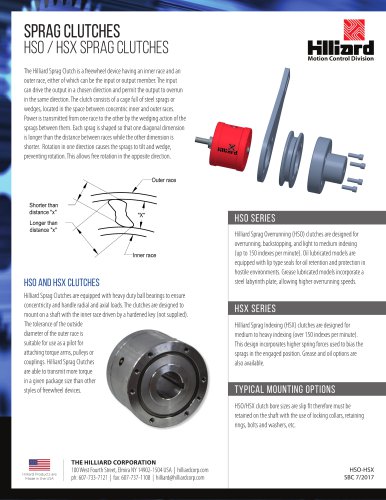 Website:
The Hilliard Corporation
Website:
The Hilliard Corporation
Catalog excerpts

Conditioning of Synthetic Lube Oils Acid Reduction of Synthetic Lubrication Fluids Phosphate ester synthetic lubricants are gaining popularity among rotating equipment manufacturers and their customers. These lubricants have a distinct advantage over mineral oils in that they have better fire resistance and high-temperature stability. These traits make them safer. Accordingly, the use of the lubricants in place of mineral-based oils can substantially reduce insurance costs. While the phosphate ester synthetic fluids are in many ways superior to mineral oils, they are not without their drawbacks. These lubricants hydrolyze and form acids. An increase in the acid number (also called Total Acid Number, or TAN) of the lubricant will result if it is not monitored carefully and treated. Lubricants with a high TAN (over 1.0) can damage pumps and bearings. This system is designed to house six 11x19 ion exchange cartridges for a total of about six cubic feet of media. The post-filter (second stage) contains a HILCO PH718-12-CN cartridge for particulate removal. Because fire-resistant phosphate ester lubricants have been used for many years for lube, hydraulic, and EHC systems, there has been an evolution of products used to control the acid number. Historically, fuller’s earth (Hilite) and activated alumina (Hilite-A) have been and continue to be specified to neutralize the acid. The latest developments include the use of Selexsorb media for conditioning Akzo’s Fyrquel phosphate ester fluids. Also, ion exchange technology is being used for fluids with additives. The advantages of ion exchange are that it has a relatively long life, contributes no mineral salts to the system, and does not remove additives (see HLE-1). Treatment of large lube oil reservoirs requires a system big enough to house large quantities of media. In some cases, fluid manufacturers recommend up to 1% by weight of media to treat the reservoir. A 2500-gallon reservoir, for instance, will need about 170 pounds of media to maintain the acid number. The system requires six or seven 11 x 19 cartridges (about 40 pounds of media per cartridge) to condition and maintain the fluid. HILCO has been manufacturing systems for synthetic fluids for several decades. No matter which type of cartridge you decide to use or how large the system, HILCO has the experience to design to the application. Typical Features · · · · · Hydraulic cover lifter Drip-pan base with channels for easy movement by fork truck Epoxy paint system compatible with phosphate ester fluids Flow meter Optional cartridge hoist HILCO® is a registered trademark of The Hilliard Corporation.
Open the catalog to page 1
The Hilliard Corporation 100 West Fourth Street, Elmira, NY 14902 U.S.A. Phone: (607) 733-7121, Fax: (607) 737-1108 http://www.hilliardcorp.com CSL-1
Open the catalog to page 2All The Hilliard Corporation catalogs and technical brochures
-
Linkless Centrifugal Clutch
1 Pages
-
Friction Torque Limiter
1 Pages
-
Intermittent Drive Assembly
1 Pages
-
Single Revolution Clutch
1 Pages
-
Enclosed Overrunning Clutch
1 Pages
-
Overrunning Sprag Clutches
4 Pages
-
Magna Torque (MTR)
1 Pages
-
HSO/HSI Sprag Clutches
4 Pages
-
Sprag Clutches
1 Pages
-
Dual Drive & Turning Gear
1 Pages
-
MTR
1 Pages
-
Magna Torque
1 Pages
-
Press-In Wheel Clutch
2 Pages
-
Auto-Lok® Differential
4 Pages
-
PTO Clutch
2 Pages
-
OVERLOAD SAFEGUARD
4 Pages
-
CENTRIFUGAL CLUTCHES
4 Pages
-
Hilsorb Dryer Cartridge
2 Pages
-
PH426 XX CG1V Element
2 Pages
-
Chips Away
2 Pages
-
Hilco Bag Filter Cartridges
2 Pages
-
Hilco Oil Mist Eliminators
4 Pages
-
Hilco Replacement Cartridges
2 Pages
-
Hilite E Filter Cartridges
2 Pages
-
PH Filter Cartridges
2 Pages
-
Products For Metalworking
2 Pages
-
HILCO® Quench Oil Reclaimer
2 Pages
-
Non-Code 718 Filter Housing
1 Pages
-
GASEOUS FUEL FILTERS
2 Pages
-
Portable Filtration
2 Pages
Archived catalogs
-
Filtration Products and Systems
24 Pages
-
Overload Release Clutches
2 Pages
-
Auto Lok Differential
4 Pages
-
Duplex Filter
2 Pages
-
Star Beverage Filter
4 Pages
-
Star Wine Filter
4 Pages
-
Star Filter Press
8 Pages































































